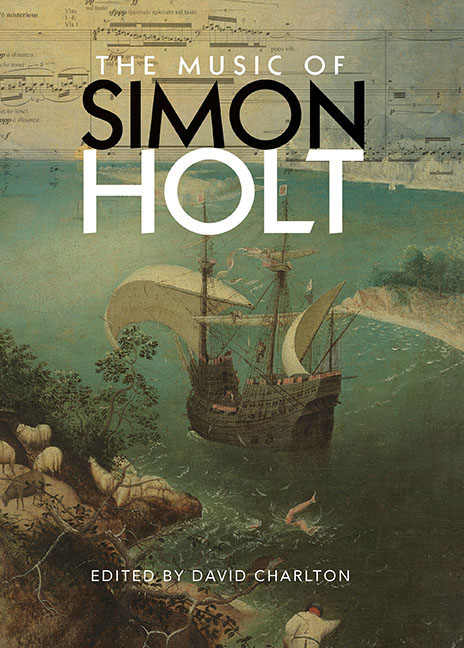Book contents
- Frontmatter
- Contents
- Figures and Tables
- Contributors
- Preface and Acknowledgements
- Abbreviations, with a note on recordings and scores
- Introduction Memories of Magical Moonlight: Simon Holt's years as a composition student
- 1 Duende y Duelos: The Andalusian spirit in the Lorca settings
- 2 An Interplay of Passion and Spirit: The Nightingale's to Blame
- 3 Images in Sound: Movement, harmony and colour in the early music
- 4 Myth and Narrative in 3 for Icarus
- 5 Sound, Sense and Syntax: The Emily Dickinson settings
- 6 Piano Music
- 7 Redefining the Cello's Voice: Musical agency in feet of clay
- 8 Performance and Reflections: Holt's music for oboe and cor anglais
- 9 Shaking the Bars: The Yellow Wallpaper
- 10 Listening to the River's Roar: Stance, texture and space in the concertos
- 11 Orchestral Works in Performance
- 12 Oblique Themes and Still Centres: A conversation between
- 13 Sketching and Idea-Gathering
- 14 Art, Conceptualism and Politics in Holt's music
- Appendix A Overview and Catalogue of Pieces
- Appendix B Texts by Simon Holt for Raju Raghuvanshi is a ghost and The Legend of Melusine
- Bibliography
- Index of pieces by Simon Holt
- General index
3 - Images in Sound: Movement, harmony and colour in the early music
Published online by Cambridge University Press: 01 September 2018
- Frontmatter
- Contents
- Figures and Tables
- Contributors
- Preface and Acknowledgements
- Abbreviations, with a note on recordings and scores
- Introduction Memories of Magical Moonlight: Simon Holt's years as a composition student
- 1 Duende y Duelos: The Andalusian spirit in the Lorca settings
- 2 An Interplay of Passion and Spirit: The Nightingale's to Blame
- 3 Images in Sound: Movement, harmony and colour in the early music
- 4 Myth and Narrative in 3 for Icarus
- 5 Sound, Sense and Syntax: The Emily Dickinson settings
- 6 Piano Music
- 7 Redefining the Cello's Voice: Musical agency in feet of clay
- 8 Performance and Reflections: Holt's music for oboe and cor anglais
- 9 Shaking the Bars: The Yellow Wallpaper
- 10 Listening to the River's Roar: Stance, texture and space in the concertos
- 11 Orchestral Works in Performance
- 12 Oblique Themes and Still Centres: A conversation between
- 13 Sketching and Idea-Gathering
- 14 Art, Conceptualism and Politics in Holt's music
- Appendix A Overview and Catalogue of Pieces
- Appendix B Texts by Simon Holt for Raju Raghuvanshi is a ghost and The Legend of Melusine
- Bibliography
- Index of pieces by Simon Holt
- General index
Summary
THERE IS NO TYPICAL Simon Holt piece, but it is characteristic of his artistic temperament that each work should address itself to listeners in an uncompromisingly direct way. The audience is often approached forcefully, even vehemently, but also with an undeniable intimacy. As a listener, one detects an urgency of voice; the tone may be confessional or expressionistic, quietly meditative or extrovertly theatrical. Holt's titles have a way of drawing one in immediately to musical worlds that are fantastical yet strikingly precise in referents. Holt's taste for shadowy and nocturnal realms is pronounced, from the early Goethe setting Lunas Zauberschein (1979: H 1) all the way through to an icicle of moon, for orchestra (2014). His attraction to the macabre or grotesque is no less palpable: Era madrugada (1984), for chamber ensemble, takes its Spanish title phrase (‘it was between night and day’) from a Lorca poem whose central image is of a dead man lying in the street with a knife in his chest. The title of the early piano piece Tauromaquia (‘Bullfighting’) denotes ritualised combat, and more specifically alludes to the series of etchings by Goya.
To observe Holt's interest in building pieces around a central image is to speak in fairly literal rather than metaphorical terms. The music somehow communicates, translates or embodies, in its own sounding language, specific images from other arts – poetry, painting, sculpture or film. When translating verbal or pictorial images (or plastic forms) into sound, though, the composer (and his critics, too) will face the obvious separation between the physicality of visual surfaces and objects and the temporality of musical forms. ‘Images’ in sound, my central concern in the present chapter, will remain translations from another artistic sphere, because paintings are confined (in Lessing's formulation) to ‘a single moment of ever-changing nature, and … a single point of view’. The absent spatial or temporal dimensions of musical or visual media do not preclude our recognising the precision with which images might be defined for their respective audiences of listeners and viewers. Approaching the images in Holt's scores, I shall focus first on their time-bound nature, i.e., their definition as figures of rhythm and tempo. The other dimensions of the sounding image to be explored here involve ‘colour’ – a category that in music engages questions of both harmony and of timbre (‘tone colour’) or instrumentation.
- Type
- Chapter
- Information
- The Music of Simon Holt , pp. 56 - 79Publisher: Boydell & BrewerPrint publication year: 2017



